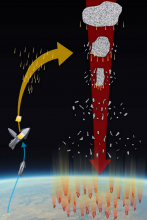Listen to today's episode of StarDate on the web the same day it airs in high-quality streaming audio without any extra ads or announcements. Choose a $8 one-month pass, or listen every day for a year for just $30.
You are here
Mars Impacts
Mars takes a pounding. The asteroid belt is just beyond it, so the planet gets hit by big space rocks that are kicked out of the belt and toward the Sun. We see the results of those impacts — big holes in the Martian landscape. Mars rovers have seen debris from the impacts — meteorites on the surface. And last year, another Mars mission “heard” an impact.
InSight arrived at Mars four years ago. It’s listened for marsquakes, and has recorded more than 1300 of them. The quakes generate waves that rumble through the planet, revealing details about how Mars is put together. The strongest quake was magnitude five — powerful enough to feel if you happened to be there.
Space rocks generate similar waves when they hit the surface. InSight recorded an impact on September 5th of last year. It heard the asteroid hit the upper atmosphere, split into three parts, then slam into the surface. The whole sequence took just a second or two.
A spacecraft in orbit later took a picture of the impact site — three fresh craters. Mission scientists dug through earlier observations and found that InSight had recorded three smaller impacts — evidence that Mars takes a pounding.
Look for Mars low in the east-northeast as night falls, to the lower left of the Moon, and climbing high across the sky later on. It looks like a bright orange star.
More about Mars and the Moon tomorrow.
Script by Damond Benningfield





